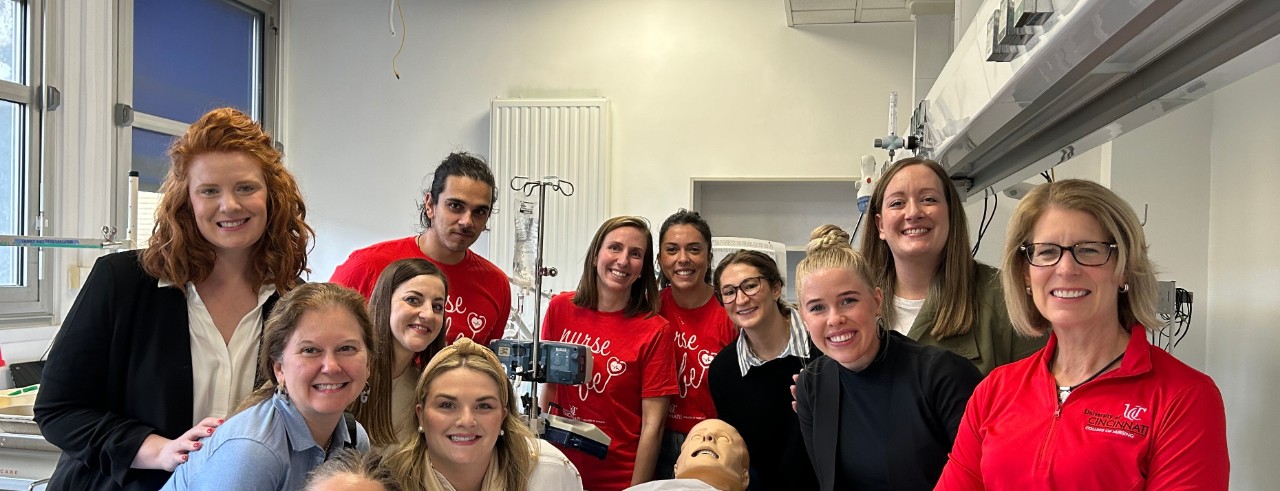
Thinking globally: Developing an international nurse anesthesia partnership
The desire to establish an international partnership has long been a goal of the University of Cincinnati (UC) College of Nursing Nurse Anesthesia Doctor of Nursing Practice program.
In 2019, the program achieved accreditation by the International Federation of Nurse Anesthetists which, among other benefits, enabled connections with like-minded international institutions.
Through the relationship developed with the Institut de Formation Interhospitalier Theodore Simon (IFITS), Beth Ann Clayton, DNP, CRNA, FAAN, FAAN, director of the UC Nurse Anesthesia program and Rachel Smith-Steinert, DNP, CRNA, FAANA, the program’s assistant director, traveled to Paris in early 2020. There, they attended the Parisian’s Nurse Anesthesia Program Global Health Day and partnered with IFITS faculty and students to create an experience that would enable UC students to expand their learning in environments that foster adaptability, cross-cultural competency and intellectual flexibility.

“The wide variety of educational, clinical and cultural experiences available in Paris and the fact that IFITS is an international university with high faculty involvement in research and scholarship made it an ideal partner,” says Clayton.
As plans were placed on hold for a few years due to the COVID pandemic, virtual communications between the two institutions continued and, last April, six UC nursing students and two faculty members traveled to Paris, France, for a long-planned week of networking and education alongside IFITS students.
The U.S. and France’s link through nurse anesthesia dates to World War I, when American nurse anesthetists cared for troops in France. Three years prior to the U.S. entering the war, Dr. George Crile and nurse anesthetists Agatha Hodgins and Mabel Littleton served in the Lakeside Unit at the American Ambulance in France and helped educate the French and British nurses and physicians in anesthesia care.
In addition to observing clinical practice in two of the largest hospitals in Paris and meeting the editor-in-chief for the European Journal of Anaesthesiology, UC students attended nurse anesthesia courses and participated in bilingual interdisciplinary simulation experiences. Working in small groups, UC and IFITS students discussed and presented on topics including nurse anesthesia scope of practice, education processes, workforce development and the impact of politics on health care delivery in both countries.

“This program was the most rewarding experience, it was such an amazing opportunity to learn about the anesthesia community in another country,” says UC nurse anesthesia student Lindsay Smart. “I valued taking time each day to debrief and reflect on what we had learned with our class group, it allowed time for reflection and appreciation of our experience.”
Students also got to visit the main touristic spots in Paris and enjoyed a potluck luncheon hosted by IFITS students, and a faculty-planned dinner at one of the oldest restaurants in the city.
“The entire experience was so eye-opening to our students. The French approach to the interdisciplinary simulation is team-oriented and prioritizes communication with mutual respect across roles, which is critical when dealing with emergencies,” says Smith-Steinert. “But the education they experienced went beyond nurse anesthesia—students were engaged in learning a new culture and a different way of life.”
While discussions for a next in person collaboration take place, on September 26 nurse anesthesia students from both institutions came together virtually for scholarly project presentations simultaneously translated through AI.
Learn more about UC's Nurse Anesthesia program.
Related Stories
Forbes: Telehealth drones bring health care to you
March 30, 2021
Forbes highlights the work of four UC inventors who are exploring how drones can be applied to telehealth.
New UC telehealth drone makes house calls
March 15, 2021
Three colleges at the University of Cincinnati collaborated to develop a semi-autonomous drone that can be dispatched right to people’s homes. The drones are big enough to carry medicine or medical supplies but small enough to maneuver the tight confines of a home using navigational algorithms developed by UC engineers so patients can talk face to face to their doctors or pharmacists.
